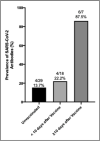Seroprevalence of SARS-CoV-2 antibodies in front-line pediatric health care workers
- PMID: 35601650
- PMCID: PMC9110875
- DOI: 10.1002/emp2.12743
Seroprevalence of SARS-CoV-2 antibodies in front-line pediatric health care workers
Abstract
Objective: The goal of this study was to determine the prevalence of SARS-CoV-2 infections in pediatric front-line health care workers (HCWs) using SARS-CoV-2 serum antibodies as an indicator of infection.
Methods: In this cross-sectional study, we collected blood samples and survey responses from HCWs in a 38-bed pediatric emergency department. Serum antibodies to SARS-CoV-2 (IgM and/or IgG) were measured using a 2-step enzyme-linked immunosorbent assay (ELISA) to detect antibodies against the Spike protein receptor binding domain (RBD), the ectodomain of Spike (S), and the nucleoprotein (N).
Results: We collected survey responses and serum samples from 54 pediatric front-line HCWs from October 2020 through April 2021. Among the 29 unvaccinated HCWs, 4 (13.7%) had antibodies to SARS-CoV-2. For the 25 vaccinated HCWs, 10 (40%) were seropositive; 3 were <10 days from the first vaccine dose and 7 were ≥10 days after the first dose. Two of the 10 seropositive vaccines had a prior positive reverse transcription polymerase chain reaction test. Individuals ≥10 days from receiving the first vaccine dose were 37.5 (95% CI: 3.5-399.3) times more likely to have SARS-CoV-2 antibodies than unvaccinated individuals or those <10 days from first vaccine dose.
Conclusions: Evidence of widespread SARS-CoV-2 infections was not found in unvaccinated front-line HCWs from a pediatric ED as of April 2021. Future work will be required to determine the reasons underlying the lower SARS-CoV-2 antibody prevalence compared to adult HCWs.
Keywords: COVID; COVID‐19; SARS‐CoV‐2 antibodies; healthcare workers; pediatric emergency department; vaccine response.
© 2022 The Authors. JACEP Open published by Wiley Periodicals LLC on behalf of American College of Emergency Physicians.
Conflict of interest statement
The authors have none to disclose.
Figures
References
-
- Hossain A, Nasrullah SM, Tasnim Z, Hasan MK, Hasan MM. Seroprevalence of SARS‐CoV‐2 IgG antibodies among health care workers prior to vaccine administration in Europe, the USA and East Asia: A systematic review and meta‐analysis. EClinicalMedicine. 2021;33:100770. Epub 2021/03/16. 10.1016/j.eclinm.2021.100770 - DOI - PMC - PubMed
LinkOut - more resources
Full Text Sources
Miscellaneous

